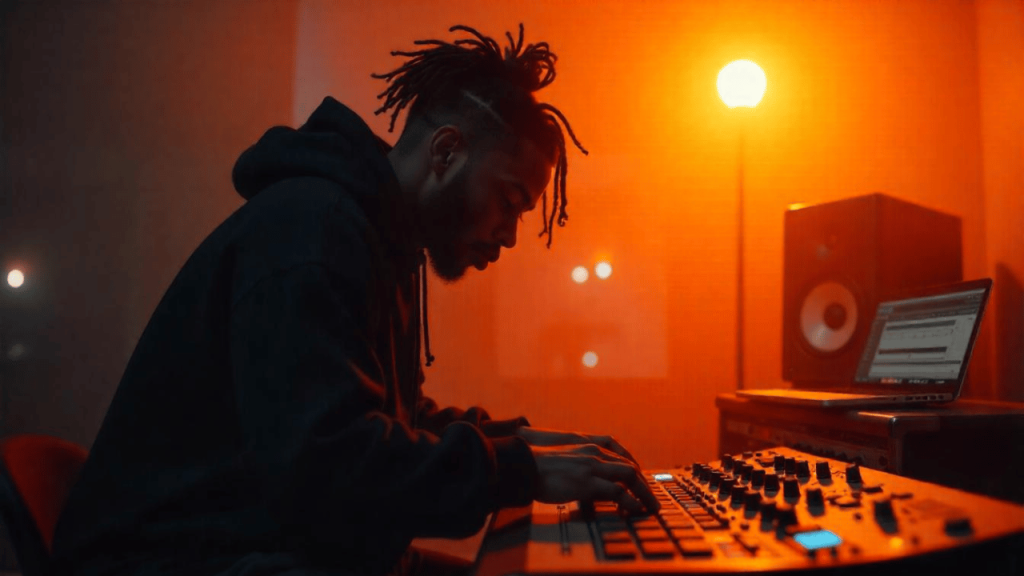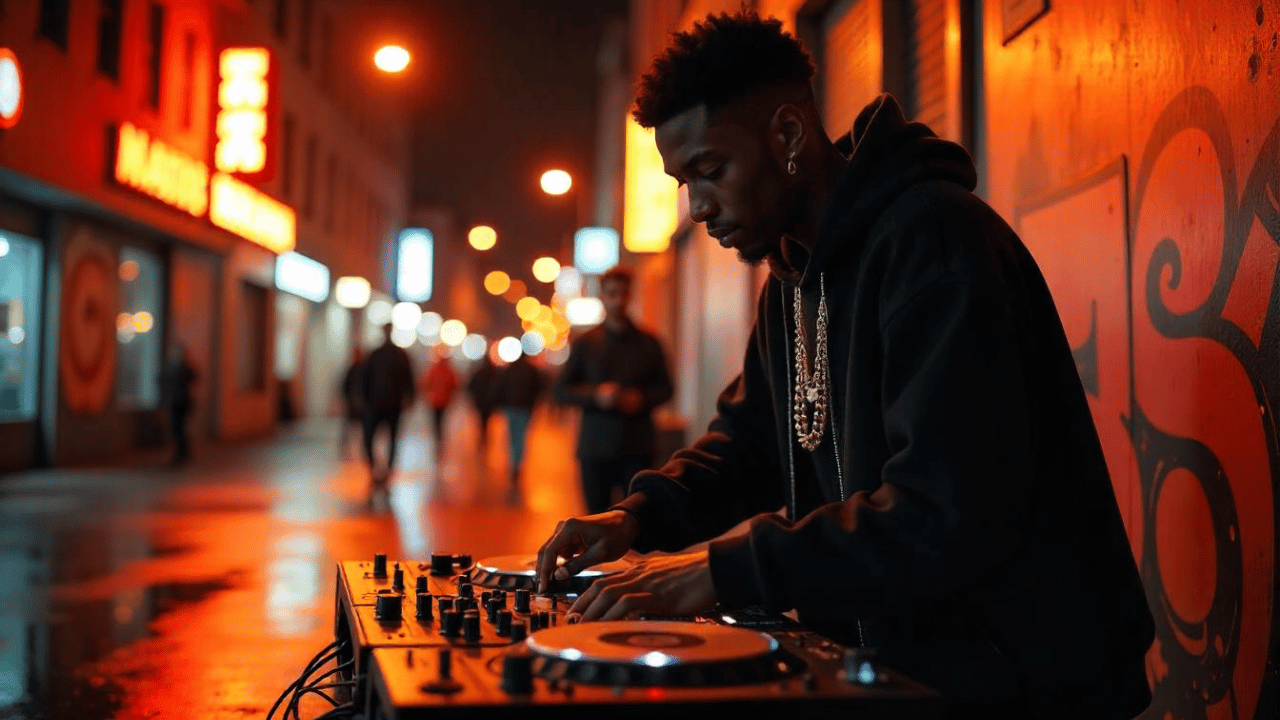The quest for the ultimate rap beat is a journey through the very soul of hip-hop and hip-hop beats, a sonic pilgrimage that began in the dusty corners of the Bronx and now reverberates across the globe. This isn’t just about technical proficiency; it’s about tapping into a cultural force, a rhythmic language that speaks of struggle, triumph, and the relentless pulse of urban life. To truly understand how to craft a beat that transcends the ordinary, one must delve into the foundational elements, the transformative techniques, and the visionary artists who have shaped this ever-evolving art form.
I. The Genesis: From Breaks to Beats
The story of the rap beat begins in the early 1970s in the South Bronx, where block parties became crucibles of a burgeoning culture . Amidst the social and economic hardships of the time, DJs like Kool Herc, Afrika Bambaataa, and Grandmaster Flash emerged as sonic architects, utilizing the humble turntable as their instrument . These pioneers didn’t just play records; they dissected them, recognizing the raw energy held within the instrumental percussion breaks – the “breaks” – of funk, soul, and disco tracks . This marked the initial form of rap beat production, a live and improvisational act where the DJ’s skill in manipulating existing recordings became the focal point . It underscores the fundamental role of the DJ in hip-hop’s inception, a figure who predates the producer as the primary creator of beats.1

Kool Herc’s ingenious “Merry-Go-Round” technique involved employing two turntables to isolate and extend these coveted breaks . By playing the same record on both decks, he could seamlessly switch back and forth, looping the percussive sections and creating a continuous rhythmic foundation that ignited the dance floor . This innovation established the core concept of looping and repetition, a principle that remains deeply embedded in rap beat production to this day.2 It also reveals an early understanding of rhythm’s profound impact on movement and audience engagement.2 By concentrating on the percussive heart of the music and prolonging it, Herc tapped into a primal human desire for rhythm in dance.2 This seemingly simple yet revolutionary technique provided the blueprint for more intricate beat structures to come.2 Initially, the role of the MC was that of a hype man, an orator who would energize the crowd over the DJ’s beats . These early vocalizations, born from the energy of the extended breaks, gradually evolved into the lyrical rhymes and rhythmic delivery that now define rap music, highlighting the crucial symbiotic relationship between the DJ and the MC in hip-hop’s formative years . The beats provided the bedrock for the lyrical storytelling that would become central to the genre.2
The late 1970s and early 1980s saw the emergence of the first recorded rap tracks, marking a transition from the live improvisation of block parties to the more structured environment of the recording studio.3 “Rapper’s Delight” by the Sugarhill Gang in 1979 stands as a pivotal early hit . Interestingly, this track often utilized live bands to emulate the techniques of the DJ, indicating a phase where the technology to directly replicate turntable wizardry in a studio setting was either unavailable or not yet widely adopted.5 This reliance on live instrumentation underscores the initial challenges in translating the improvisational energy of a DJ set into a recorded format.5 However, the introduction of drum machines like the Roland TR-808 in 1980 and the Oberheim DMX signaled a significant shift towards electronic beat production . These machines offered a way to program original drum patterns, democratizing the beat-making process and allowing for the creation of unique sounds and rhythms that went beyond the confines of existing records . The TR-808, with its distinctive sonic character, would soon become an iconic sound in hip-hop . Afrika Bambaataa’s “Planet Rock” in 1982 further cemented this electronic direction . This groundbreaking track not only popularized the TR-808 but also boldly incorporated samples of electronic sounds from Kraftwerk, giving birth to the electro-hip-hop genre . “Planet Rock” showcased the immense potential of blending electronic music with hip-hop’s rhythmic sensibilities, expanding the sonic palette of rap and demonstrating an early, innovative application of sampling technology . Bambaataa’s willingness to experiment with sounds beyond the traditional funk and soul foundation opened up entirely new sonic landscapes for hip-hop, influencing countless producers in the years that followed .
II. The Toolkit: Building the Sound
The evolution of rap beat production is intrinsically linked to the tools and techniques employed by its creators. Sampling, the art of borrowing and transforming existing audio, has been a cornerstone of the genre since its inception . While DJs were effectively performing live sampling with turntables 8, it wasn’t until 1984 that Kurtis Blow became the first hip-hop artist to utilize a digital sampler, the Fairlight CMI, on his album.12 Early samplers, however, came with significant limitations.13 Their short sample times and high costs ironically spurred creativity.13 Producers were forced to be resourceful, carefully selecting brief audio snippets and manipulating them to maximize their impact, leading to techniques like chopping and layering.17 With mere seconds of sampling time, entire musical phrases were out of reach; instead, the focus shifted to extracting rhythmic and melodic fragments and recontextualizing them.17
The mid to late 1980s saw the rise of more accessible and influential samplers like the E-mu SP-12 and SP-1200, followed by the Akai MPC series . These hardware units became central to hip-hop production, each possessing its own distinct sonic characteristics and workflow that shaped the sound of different eras and geographical regions . The Akai MPC, in particular, revolutionized beatmaking by combining sampling capabilities with an intuitive onboard sequencer, becoming the centerpiece of many producers’ studios . The tactile interface and unique sound processing of these machines contributed significantly to the sonic aesthetics of the “Golden Era” and beyond . Producers employed a range of sampling techniques, including looping, where a segment of audio is repeated; chopping, which involves breaking a sample into smaller parts for rearrangement; layering, the combination of multiple samples; reversing, playing a sample backward; pitch shifting, altering the sample’s tonal height; and time stretching, changing its duration without affecting pitch.17 These methods allowed for the complete transformation of existing music, showcasing the creative potential of sampling far beyond mere replication.17 The act of “flipping” a sample, taking a familiar sound and turning it into something entirely new, became a celebrated art form.17

The evolution of sampling techniques in the 1980s and 1990s was also significantly influenced by both technological advancements and a growing awareness of legal issues.8 Landmark copyright cases in the early 1990s, such as the lawsuit against De La Soul and the Biz Markie case, brought the legal ramifications of unauthorized sampling into sharp focus.8 This led to a decrease in the density of samples used in tracks and an increased emphasis on either clearing samples legally or seeking out more obscure and less recognizable sources.8 The legal crackdown on unauthorized borrowing forced producers to become more strategic and inventive in their approach to sample selection and manipulation, ultimately leading to new aesthetic directions within the genre.8
Sequencing, the art of arranging these sonic elements into a cohesive musical structure, is another fundamental aspect of rap beat production.8 Early sequencers were often integrated directly into drum machines and samplers, exemplified by the Akai MPC.8 The introduction of MIDI provided a standardized language for various music technologies to communicate and synchronize.7 This innovation revolutionized music production by enabling different electronic instruments to work together seamlessly, allowing for more intricate arrangements and streamlined workflows.7 Before MIDI, coordinating multiple pieces of electronic music gear was a complex and often frustrating process.7 MIDI provided a universal protocol for these devices to interact, unlocking new possibilities for sequencing and arranging musical ideas.7 The late 1980s and 1990s witnessed a gradual but significant transition from dedicated hardware sequencers to software-based Digital Audio Workstations (DAWs).8 This shift provided producers with greater flexibility, more advanced editing capabilities, and access to a vast array of virtual instruments and effects, further democratizing the process of music creation.8
DAWs essentially integrated all the necessary tools for beat production – sequencing, sampling, synthesis, mixing, and mastering – into a single software environment, making the process more accessible and significantly more powerful.8 Early DAWs and their precursors, such as the Synclavier, Fairlight CMI, the Atari ST with software like Notator (later Logic), Digidesign’s Sound Tools (which evolved into Pro Tools), and Steinberg’s Cubase, represent a continuous evolution towards more integrated and user-friendly music production environments . These early systems, while groundbreaking for their time, were often expensive and had steep learning curves . Over time, advancements in computing power and software design led to the more affordable and intuitive DAWs that are now standard in music production .
Sound design, the art of crafting the sonic palette of a rap beat, is another crucial element.24 Early hip-hop soundscapes were often characterized by relatively simple beats, prominent funky basslines, and the creative use of samples . However, the integration of synthesizers, such as the Moog and the Yamaha DX7, allowed producers to introduce original melodies, basslines, and textural elements . Synthesizers expanded the sonic possibilities of rap beats beyond the realm of sampled sounds, providing a means to create unique melodic and harmonic content . The Yamaha DX7, with its distinctive digital sound, became particularly prevalent in the late 1980s and early 1990s . While early rap heavily relied on the sounds of existing records, synthesizers offered a way to generate sounds that were entirely new, contributing to the genre’s constantly evolving sonic identity . The rhythmic foundation of a rap beat is paramount, with the kick drum providing the low-end thump, the snare adding a sharp attack, the hi-hats contributing energy and nuance, and various percussion elements adding flavor and depth . Each of these elements plays a distinct role in shaping the groove and overall energy of the track . Variations in the patterns and the specific sound selections for these elements are key differentiators between various hip-hop subgenres .

The interplay between the kick, snare, hi-hats, and other percussive sounds creates the fundamental rhythmic feel of a rap beat . Producers manipulate these core elements to craft different styles, ranging from the classic boom-bap with its emphasis on the kick and snare to the more intricate and often syncopated rhythms found in trap music . Ultimately, sound design in hip-hop transcends simply choosing samples or using preset sounds on a synthesizer.24 It is an active creative process that involves shaping and molding sounds through techniques like equalization (EQ) to sculpt the frequency spectrum, compression to control dynamics, layering multiple sounds to create richer textures, and the application of various effects to add character and spatial depth.24 Producers often take raw sonic materials – whether sourced from samples or generated synthetically – and meticulously process them to perfectly fit the specific vibe and character they envision for their beats, demonstrating a deep understanding of sonic manipulation and its impact on the final product.24

III. Sonic Architects: The Signature Styles
The history of rap beat production is populated by visionary sonic architects who have left an indelible mark on the genre. The early pioneers – Kool Herc, Grandmaster Flash, and Afrika Bambaataa – laid the groundwork through their innovative DJ techniques, emphasis on extending breaks, and early explorations into electronic sounds . These figures established the foundational elements of hip-hop beatmaking by ingeniously utilizing the technology available to them, setting the stage for future generations of producers to build upon their innovations . Their experimentation with turntables and the nascent field of electronic music production paved the way for the evolution of rap beats from simple looped breaks to more complex and layered arrangements .
The period spanning the mid-1980s to the mid-1990s, often referred to as the Golden Era, witnessed an explosion of diverse styles and the emergence of numerous influential producers who crafted signature sounds that defined the era.8 Heavy use of sampling was a hallmark of this period, and producers like Marley Marl, Rick Rubin, the Bomb Squad, Dr. Dre, DJ Premier, Pete Rock, RZA, and J Dilla developed distinct sonic palettes that often became synonymous with specific regional sounds and subgenres.8 The relative freedom in sampling, before stricter copyright laws were heavily enforced, coupled with the increasing sophistication of sampling technology, allowed for an unprecedented level of creativity and innovation.8
The Bomb Squad, known for their work with Public Enemy, revolutionized hip-hop production with their dense and layered sound, often combining dozens of samples within a single track . Their chaotic and sample-heavy style mirrored the urgent social commentary and revolutionary spirit of Public Enemy’s lyrics, pushing the boundaries of what was possible with sample-based production . In stark contrast, Dr. Dre, first with N.W.A. and later as a solo artist, pioneered the G-funk sound, characterized by its smooth synth basslines, minimal sampling, and often the incorporation of live instrumentation.8 Dre’s polished and groove-oriented production defined the sound of West Coast hip-hop in the early 1990s, influencing a vast number of producers.8 On the East Coast, DJ Premier’s signature boom-bap style became the sonic backbone for artists like Gang Starr and Nas.27
Premier's sound was characterized by its use of jazz samples, hard-hitting, often unquantized drums, and intricate scratching, becoming synonymous with the raw energy of hardcore hip-hop.27 RZA, the driving force behind the Wu-Tang Clan, cultivated a distinct gritty and lo-fi aesthetic.18 His production often featured low-rumbling basslines, sharp snare drums, and a unique sampling style that frequently incorporated sound clips from kung fu films, contributing significantly to the Wu-Tang Clan's unique and influential sound.18 Towards the end of the Golden Era and beyond, J Dilla emerged as a highly influential figure, known for his "drunken" or slightly off-kilter rhythms, innovative and often unexpected sample flips, and overall soulful vibe.27 His unique rhythmic feel and highly creative approach to sampling have inspired countless contemporary producers.27
Since the late 1990s, rap beat production has continued its dynamic evolution, fueled by advancements in technology and the emergence of new subgenres like trap, cloud rap, and drill.8 This ongoing evolution reflects the genre’s inherent capacity for reinvention and its constant engagement with new sonic possibilities.8
IV. The Beat’s Echo: Cultural Resonance
Iconic rap beats have played a pivotal role in shaping the very sound of hip-hop, serving as defining elements of specific eras and subgenres.8 Certain beats have become so deeply ingrained in the cultural consciousness that they are instantly recognizable and forever associated with particular artists, albums, and pivotal moments in hip-hop history.8 This underscores the powerful role that production plays in establishing and maintaining hip-hop’s identity.8 Just as a memorable melody can define a song in other genres, a distinctive beat can become the sonic signature of an artist or an entire era within the vast landscape of hip-hop.8
The impact of rap beats extends beyond the purely auditory realm. The rhythm and energy inherent in these beats have been a driving force behind the development of breakdancing, a fundamental element of hip-hop culture.54 The percussive and often repetitive nature of early rap beats provided the ideal rhythmic foundation for the acrobatic movements and improvisational spirit of breakdancers.54 Furthermore, the sonic aesthetic of different eras of rap music has often translated into visual styles and fashion trends associated with the genre.51
Rap beats have also served as a powerful reflection of the social and political contexts from which they emerged.8 Particularly in subgenres like hardcore and gangsta rap, producers often incorporated sounds and textures that mirrored the realities and struggles of urban life, creating a sonic backdrop for narratives of poverty, social injustice, and the challenges of inner-city environments.8 The use of sirens, gunshots, and other urban soundscapes within these beats helped to create an immersive and authentic representation of the communities that gave birth to the music.8
The influence of rap beats has transcended geographical boundaries, exerting a profound impact on other genres and cultures worldwide.8 Rap beat production techniques, the distinctive sounds of drum machines like the TR-808, and the rhythmic patterns pioneered in hip-hop have been adopted and adapted by artists across a wide spectrum of musical styles, including pop, R&B, electronic music, and even country.8 This demonstrates the widespread cultural influence and the pervasive impact of rap’s sonic innovations on the global musical landscape.8

V. The Authenticity Paradox: Craft vs. Code
The world of rap beat production is not without its internal debates and contrasting philosophies. The practice of sampling, while foundational to the genre, has been a subject of ongoing discussion regarding ethics and copyright.8 Contrasting views exist on whether the act of taking segments from existing recordings constitutes borrowing or stealing.8 The tightening of copyright laws in the early 1990s significantly impacted sampling practices, forcing producers to navigate complex legal issues surrounding ownership and creativity, leading to discussions about originality and fair use.8 While sampling remains a vital technique, the legal landscape has undeniably shaped how it is approached.8
A constant tension also exists between the desire for authenticity and the drive for innovation.8 Producers grapple with the challenge of honoring the traditions and foundational sounds of hip-hop while simultaneously embracing new sonic possibilities offered by evolving technologies.8 The very definition of the “ultimate” rap beat often lies in finding this delicate balance between the familiar and the groundbreaking.8 While a deep respect for hip-hop’s rich history is crucial, the genre has always thrived on pushing creative boundaries and exploring uncharted sonic territories.8 Therefore, the ultimate beat likely incorporates both recognizable elements of the past and fresh, forward-thinking ideas that point towards the future.8
The ever-increasing role of technology in beat production also sparks debates about its impact on the craft.17 The accessibility and power of tools like DAWs and AI-powered software have undoubtedly democratized music production and offer unprecedented creative options.17 However, concerns linger about whether this reliance on technology might lead to a homogenization of sound and a potential decline in the artistry and skill traditionally associated with beatmaking.17 While technology can undoubtedly be a powerful tool for progress, the question remains whether an over-dependence on it could ultimately shortcut the creative process and diminish the unique human element that has always been at the heart of hip-hop.17
VI. The Rhyme and the Rhythm: Producer-Rapper Dynamics
The creation of a truly compelling rap track is rarely a solitary endeavor; it often involves a dynamic interplay between the rapper and the producer.115 This collaborative process is crucial, with each artist bringing their unique skills and perspectives to the table.115 The synergy between the rapper’s lyrical content and vocal delivery and the producer’s rhythmic and sonic landscape is often the key ingredient for a successful song.115 The producer’s role typically extends far beyond simply creating a beat.125 They often contribute significantly to shaping the overall sound and feel of a track, assisting with arrangement, and even composing instrumental parts to enhance the song’s impact.125 Many producers also handle the technical aspects of recording and engineering, guiding the artist’s performance and ensuring the sonic quality of the final product.125
Producers frequently tailor their beatmaking approach to the specific style, flow, and lyrical themes of the rapper they are collaborating with.2 Understanding the artist’s brand and sonic identity is paramount in crafting a beat that will complement their strengths and resonate with their audience.2 A beat that might be perfect for one rapper could be entirely unsuitable for another, highlighting the importance of a producer’s versatility and adaptability.2 The history of hip-hop is rich with iconic rapper-producer duos who have consistently created groundbreaking music, underscoring the significance of strong creative partnerships within the genre.35 Collaborations like Dr. Dre and Snoop Dogg, DJ Premier and Guru, Kanye West and Pusha T, and Metro Boomin and 21 Savage have resulted in signature sounds that have defined both artists and shaped the trajectory of hip-hop.35 When a rapper and producer develop a strong creative chemistry and a shared vision, they can push each other to new artistic heights, resulting in timeless and highly influential music.35
VII. Beyond the Booth: Wider Cultural Currents
The evolution of the rap beat has not occurred in a vacuum; it has been deeply influenced by a rich tapestry of musical traditions and broader cultural currents. Funk and soul music provided the foundational rhythmic and melodic elements for early hip-hop.8 DJs and producers extensively sampled drum breaks, basslines, and other sonic textures from these genres, recognizing the inherent groove and energy that resonated with the emerging hip-hop culture.8 The emphasis on rhythm, improvisation, and often socially conscious lyrics in funk and soul made them natural and fertile sources for sampling and inspiration.8
The vibrant sound system culture of Jamaica, including the practices of “toasting” (rapping or chanting over music) and “dubbing” (remixing tracks with a focus on bass and rhythm), also played a crucial role in the early development of hip-hop, particularly in the burgeoning scene in New York City.18 Jamaican immigrants like DJ Kool Herc brought these cultural traditions and musical techniques to the Bronx, where they were adapted and evolved into the very foundations of hip-hop as we know it today.18
Jazz music has also been a significant source of inspiration for hip-hop producers.26 Many producers have sampled jazz’s complex harmonies, improvisational spirit, and distinctive instrumentation, leading to the creation of the jazz rap subgenre and enriching the overall sonic palette of hip-hop.26 The sophisticated musicality of jazz provided a compelling contrast to the rawer sounds of early hip-hop, offering producers new and exciting avenues for creative exploration and adding layers of harmonic complexity to their beats.26
Furthermore, hip-hop producers have drawn inspiration from rock music.26 Sampling powerful rock riffs, energetic drum breaks, and sometimes even collaborating directly with rock artists has blurred the lines between genres and further expanded the sonic possibilities within rap music.26 The raw energy and often rebellious spirit of rock music resonated with certain aspects of hip-hop culture, leading to intriguing cross-genre experimentation and the creation of unique sonic fusions.26
Electronic music has been intertwined with hip-hop since its early stages.8 The early adoption of drum machines and synthesizers played a critical role in shaping hip-hop’s sound, leading to the emergence of electro-hip-hop and a continued integration of various electronic music elements into contemporary rap.8 The futuristic sounds and rhythmic possibilities offered by electronic instruments appealed to hip-hop artists who were eager to break new ground and create music that reflected a modern, urban experience.8
Underlying all these musical influences is the profound impact of societal trends.8 Rap beat production has always been deeply intertwined with the social, economic, and political realities of the communities from which it originated.8 The evolution of the music mirrors broader cultural shifts and technological advancements, serving as both a soundtrack to and a commentary on the ever-changing world.8
VIII. The Horizon: Future Sounds and Tech
Looking ahead, the landscape of rap beat production is poised for further transformation, driven by emerging trends and technological innovations. Genre blending and style fusion are expected to become even more prevalent . Artists and producers will likely continue to push creative boundaries, drawing influences from an increasingly diverse range of musical styles, including drill, rock, electronic music, and even country, leading to exciting and novel hybrid forms of rap .
Artificial intelligence (AI) is also anticipated to have a significant impact on the future of rap beat production . AI-powered tools are already emerging that can generate original beats and samples, as well as assist with the technical aspects of mixing and mastering . While this has the potential to further democratize beatmaking and offer new creative avenues, it also raises important questions about originality, the role of human creativity, and the potential for homogenization of sound .
The trend of increasingly accessible and affordable music production software and online platforms is expected to continue.61 This will likely empower even more aspiring producers to create and share their music with a global audience, leading to an increasingly diverse and decentralized landscape for rap beat production.61 The internet will continue to play a crucial role, further revolutionizing how rap beats are made and shared 8, facilitating remote collaborations, online beat marketplaces, and direct-to-artist distribution, fostering a truly global community of beatmakers.8 Finally, emerging technologies like virtual reality (VR) and augmented reality (AR) hold the potential to influence live performances and even the music creation process itself.103 These technologies could offer new and immersive ways for artists to present their music and for producers to craft soundscapes in three-dimensional environments, pushing the boundaries of the traditional rap beat experience.103
Conclusions
The journey of the rap beat, from its humble beginnings in the Bronx to its current global dominance, is a testament to the power of human creativity and the relentless evolution of technology. The ultimate rap beat is not a static formula but rather a dynamic convergence of historical understanding, technical skill, cultural awareness, and a willingness to push sonic boundaries. It respects the foundational elements laid down by the pioneers while fearlessly embracing the innovations of the future. As technology continues to advance and musical influences intertwine, the landscape of rap beat production will undoubtedly continue to evolve, offering endless possibilities for sonic exploration and the creation of rhythms that move bodies and minds alike. The true essence of crafting the ultimate rap beat lies not just in mastering the tools but in channeling the spirit and energy of hip-hop itself, creating a sound that is both authentic and groundbreaking
